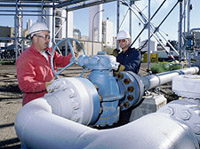
Technologies
Carbon Sequestration
NETL’s Carbon Sequestration Program is helping to develop technologies to capture, purify, and store carbon dioxide (CO2) in order to reduce greenhouse gas emissions without adversely influencing energy use or hindering economic growth. Carbon sequestration technologies capture and store CO2 that would otherwise reside in the atmosphere for long periods of time.
| |
 |
Weyburn Carbon Dioxide
Sequestration Project |
| |
Worldwide CO2 emissions from human activity have increased from an insignificant level two centuries ago to more than 33 billion tons today. The U.S. Energy Information Administration predicts that, if no action is taken, the United States will emit 8,800 million tons of CO2 by 2030, a 33 percent increase above 2005 emission levels.
The Carbon Sequestration Program contributes significantly to the President’s goal of developing technologies to substantially reduce greenhouse gas emissions. By 2012, NETL envisions having a technology portfolio of safe, cost-effective, commercial-scale greenhouse gas capture, storage, and mitigation technologies, leading to substantial deployment and market penetration.
NETL’s primary Carbon Sequestration research and development (R&D) objectives are: (1) lowering the cost and energy penalty associated with CO2 capture from large point sources; and (2) improving the understanding of factors affecting CO2 storage permanence, capacity, and safety in geologic formations and terrestrial ecosystems. Once these objectives are met, new and existing power plants and fuel processing facilities in the U.S. and around the world will have the potential to be retrofitted with CO2 capture technologies.
Carbon capture and sequestration begins with the separation and capture of CO2 from power plant flue gas and other stationary CO2 sources. At present, this process is costly and energy intensive, accounting for the majority of the cost of sequestration. However, analysis shows the potential for cost reductions of 30–45 percent for CO2 capture. Post-combustion, pre-combustion, and oxy-combustion capture systems being developed are expected to be capable of capturing more than 90 percent of flue gas CO2.
The next step is to sequester (store) the CO2. The primary means for carbon storage are injecting CO2 into geologic formations or using terrestrial applications. Geologic sequestration involves taking the CO2 that has been captured from power plants and other stationary sources and storing it in deep underground geologic formations in such a way that CO2 will remain permanently stored. Geologic formations such as oil and gas reservoirs, unmineable coal seams, and underground saline formations are potential options for storing CO2. Storage in basalt formations and organic rich shales is also being investigated.
Terrestrial sequestration involves the net removal of CO2 from the atmosphere by plants and microorganisms that use CO2 in their natural cycles. Terrestrial sequestration requires the development of technologies to quantify with a high degree of precision and reliability the amount of carbon stored in a given ecosystem. Program efforts in this area are focused on increasing carbon uptake on mined lands and evaluation of no-till agriculture, reforestation, rangeland improvement, wetlands recovery, and riparian restoration. These activities complement collaborative research with the U.S. Department of Agriculture, DOE Office of Science, U.S. EPA, and U.S. Department of the Interior.
The Carbon Sequestration Program involves two key elements for technology development: Core R&D, and Demonstration and Deployment.
Core R&D, accomplished through laboratory and pilot-scale research, develops new technologies and systems for reducing greenhouse gas emissions from industrial sources. Core R&D integrates basic research and computational sciences to study advanced materials and energy systems. For example, NETL research and ongoing data collection on CO2 storage has resulted in computer models that predict storage capacity and the permanence of CO2 storage. Core R&D focuses on five areas for carbon sequestration technology development: (1) CO2 Capture, (2) Carbon Storage, (3) Monitoring, Mitigation, and Verification, (4) Non-CO2 Greenhouse Gas Control, and (5) Breakthrough Concepts.
Demonstration and Deployment speeds the development of new technologies through initiatives such as DOE’s Regional Carbon Sequestration Partnerships and other commercial opportunities. Demonstration projects also provide “lessons learned” for Core R&D scientists to develop further technology solutions and innovations.
The Regional Carbon Sequestration Partnerships are collaborations between government, industry, universities, and international organizations funded by DOE to determine the most suitable technologies, regulations, and infrastructure needs for carbon capture and sequestration. Starting in 2008, large-volume sequestration tests are scheduled to begin to demonstrate the potential to store hundreds of years of CO2 emissions. Technologies are being validated at test sites in the United States and Canada, and ongoing data collection is confirming geologic and terrestrial sequestration capacity and effectiveness.
DOE emphasizes monitoring, mitigation, and verification (MM&V), as well as risk assessment at the sequestration site. MM&V efforts focus on the development and deployment of technologies that can provide an accurate accounting of stored CO2, and a high level of confidence that the CO2 will remain permanently sequestered. Effective application of these MM&V technologies will ensure the safety of sequestration projects with respect to both human health and the environment, and provide the basis for establishing carbon credit trading markets for sequestered CO2. Risk assessment research focuses on identifying and quantifying potential risks to humans and the environment associated with CO2 sequestration, and helping to ensure that these risks remain low.
In addition, DOE participates in the Carbon Sequestration Leadership Forum, an international climate change initiative that is focused on the development of improved, cost-effective technologies for the separation and capture of CO2 and for its transport and long-term safe storage. The purpose of the Carbon Sequestration Leadership Forum (CSLF) is to make these technologies available internationally and to identify and address wider issues relating to carbon capture and storage. Through the DOE NETL Carbon Sequestration Core R&D Program, numerous international projects, that are also CSLF-endorsed, are supported. U.S. technological advances and expertise in Greenhouse Gas mitigation are being shared in initiatives such as the Australian Otway Basin project [PDF-3MB], the European Union funded CO2SINK project in Germany, the Algerian In Salah industrial-scale CO2 storage project, and the IEA GHG Weyburn-Midale CO2 Monitoring and Storage Project in Canada.
|